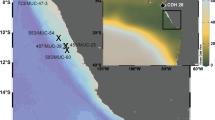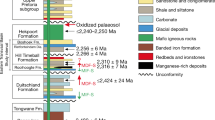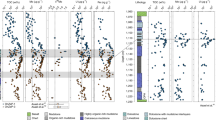Abstract
The oxygenation of the deep ocean in the geological past has been associated with a rise in the partial pressure of atmospheric molecular oxygen (O2) to near-present levels and the emergence of modern marine biogeochemical cycles1,2,3,4,5. It has also been linked to the origination and diversification of early animals3,5,6,7. It is generally thought that the deep ocean was largely anoxic from about 2,500 to 800 million years ago1,2,3,4,5,6,7,8,9,10,11,12, with estimates of the occurrence of deep-ocean oxygenation and the linked increase in the partial pressure of atmospheric oxygen to levels sufficient for this oxygenation ranging from about 800 to 400 million years ago3,5,7,11,13. Deep-ocean dissolved oxygen concentrations over this interval are typically estimated using geochemical signatures preserved in ancient continental shelf or slope sediments, which only indirectly reflect the geochemical state of the deep ocean. Here we present a record that more directly reflects deep-ocean oxygen concentrations, based on the ratio of Fe3+ to total Fe in hydrothermally altered basalts formed in ocean basins. Our data allow for quantitative estimates of deep-ocean dissolved oxygen concentrations from 3.5 billion years ago to 14 million years ago and suggest that deep-ocean oxygenation occurred in the Phanerozoic (541 million years ago to the present) and potentially not until the late Palaeozoic (less than 420 million years ago).
This is a preview of subscription content, access via your institution
Access options
Access Nature and 54 other Nature Portfolio journals
Get Nature+, our best-value online-access subscription
$29.99 / 30 days
cancel any time
Subscribe to this journal
Receive 51 print issues and online access
$199.00 per year
only $3.90 per issue
Buy this article
- Purchase on Springer Link
- Instant access to full article PDF
Prices may be subject to local taxes which are calculated during checkout




Similar content being viewed by others
References
Canfield, D. E. in Treatise on Geochemistry (eds Holland, H. D. & Turekian, K. K. ) 197–216 (Elsevier, 2014)
Canfield, D. E. The early history of atmospheric oxygen: homage to Robert M. Garrels. Annu. Rev. Earth Planet. Sci. 33, 1–36 (2005)
Canfield, D. E., Poulton, S. W. & Narbonne, G. M. Late-Neoproterozoic deep-ocean oxygenation and the rise of animal life. Science 315, 92–95 (2007)
Lyons, T. W., Reinhard, C. T. & Planavsky, N. J. The rise of oxygen in Earth’s early ocean and atmosphere. Nature 506, 307–315 (2014)
Sahoo, S. K. et al. Ocean oxygenation in the wake of the Marinoan glaciation. Nature 489, 546–549 (2012)
Planavsky, N. J. et al. Low Mid-Proterozoic atmospheric oxygen levels and the delayed rise of animals. Science 346, 635–638 (2014)
Dahl, T. W. et al. Devonian rise in atmospheric oxygen correlated to the radiations of terrestrial plants and large predatory fish. Proc. Natl Acad. Sci. USA 107, 17911–17915 (2010)
Slack, J., Grenne, T., Bekker, A., Rouxel, O. & Lindberg, P. Suboxic deep seawater in the late Paleoproterozoic: evidence from hematitic chert and iron formation related to seafloor-hydrothermal sulfide deposits, central Arizona, USA. Earth Planet. Sci. Lett. 255, 243–256 (2007)
Canfield, D. E. et al. Ferruginous conditions dominated later Neoproterozoic deep-water chemistry. Science 321, 949–952 (2008)
Sperling, E. A. et al. Statistical analysis of iron geochemical data suggests limited late Proterozoic oxygenation. Nature 523, 451–454 (2015)
Scott, C. et al. Tracing the stepwise oxygenation of the Proterozoic ocean. Nature 452, 456–459 (2008)
Canfield, D. E. A new model for Proterozoic ocean chemistry. Nature 396, 450–453 (1998)
Blamey, N. J. et al. Paradigm shift in determining Neoproterozoic atmospheric oxygen. Geology 44, 651–654 (2016)
Scott, A. C. & Glasspool, I. J. The diversification of Paleozoic fire systems and fluctuations in atmospheric oxygen concentration. Proc. Natl Acad. Sci. USA 103, 10861–10865 (2006)
Belcher, C. & McElwain, J. Limits for combustion in low O2 redefine paleoatmospheric predictions for the Mesozoic. Science 321, 1197–1200 (2008)
Sarmiento, J. L. & Gruber, N. Ocean Biogeochemical Dynamics (Princeton Univ. Press, 2006)
Bach, W. & Edwards, K. J. Iron and sulfide oxidation within the basaltic ocean crust: implications for chemolithoautotrophic microbial biomass production. Geochim. Cosmochim. Acta 67, 3871–3887 (2003)
Dilek, Y. & Furnes, H. Ophiolite genesis and global tectonics: geochemical and tectonic fingerprinting of ancient oceanic lithosphere. Geol. Soc. Am. Bull. 123, 387–411 (2011)
Kasting, J. F. et al. Paleoclimates, ocean depth, and the oxygen isotopic composition of seawater. Earth Planet. Sci. Lett. 252, 82–93 (2006)
Nilsson, K. & Peach, C. L. Sulfur speciation, oxidation state, and sulfur concentration in backarc magmas. Geochim. Cosmochim. Acta 57, 3807–3813 (1993)
Staudigel, H., Plank, T., White, B. & Schmincke, H. U. Geochemical fluxes during seafloor alteration of the basaltic upper oceanic crust: DSDP Sites 417 and 418. Geophys. Monogr. Ser. 96, 19–38 (1996)
Kelley, K. A. & Cottrell, E. Water and the oxidation state of subduction zone magmas. Science 325, 605–607 (2009)
Keller, C. B. & Schoene, B. Statistical geochemistry reveals disruption in secular lithospheric evolution about 2.5 Gyr ago. Nature 485, 490–493 (2012)
Halevy, I. & Bachan, A. The geologic history of seawater pH. Science 355, 1069–1071 (2017)
Hofmann, A. & Harris, C. Silica alteration zones in the Barberton greenstone belt: a window into subseafloor processes 3.5–3.3 Ga ago. Chem. Geol. 257, 221–239 (2008)
Berner, R. A. Phanerozoic atmospheric oxygen: new results using the GEOCARBSULF model. Am. J. Sci. 309, 603–606 (2009)
Bergman, N. M., Lenton, T. M. & Watson, A. J. COPSE: a new model of biogeochemical cycling over Phanerozoic time. Am. J. Sci. 304, 397–437 (2004)
Laakso, T. A. & Schrag, D. P. Regulation of atmospheric oxygen during the Proterozoic. Earth Planet. Sci. Lett. 388, 81–91 (2014)
Stolper, D. A., Bender, M. L., Dreyfus, G. B., Yan, Y. & Higgins, J. A. Pleistocene ice core record of atmospheric O2 concentrations. Science 353, 1427–1430 (2016)
Li, Z.-X. A. & Lee, C.-T. A. The constancy of upper mantle fO2 through time inferred from V/Sc ratios in basalts. Earth Planet. Sci. Lett. 228, 483–493 (2004)
Kump, L. R., Kasting, J. F. & Barley, M. E. Rise of atmospheric oxygen and the “upside-down” Archean mantle. Geochem. Geophys. Geosyst. 2, 1025 (2001)
Andersen, M. B. et al. The terrestrial uranium isotope cycle. Nature 517, 356–359 (2015)
Furnes, H., Dilek, Y. & De Wit, M. Precambrian greenstone sequences represent different ophiolite types. Gondwana Res. 27, 649–685 (2015)
Furnes, H., De Wit, M. & Dilek, Y. Four billion years of ophiolites reveal secular trends in oceanic crust formation. Geosci. Front. 5, 571–603 (2014)
Lécuyer, C. & Ricard, Y. Long-term fluxes and budget of ferric iron: implication for the redox states of the Earth’s mantle and atmosphere. Earth Planet. Sci. Lett. 165, 197–211 (1999)
Pallister, J. S., Budahn, J. R. & Murchey, B. L. Pillow basalts of the Angayucham terrane: oceanic plateau and island crust accreted to the Brooks Range. J. Geophys. Res. Solid Earth 94, 15901–15923 (1989)
Johnson, H. P. & Semyan, S. W. Age variation in the physical properties of oceanic basalts: implications for crustal formation and evolution. J. Geophys. Res. Solid Earth 99, 3123–3134 (1994)
Rybacki, K., Kump, L., Hanski, E. & Melezhik, V. Weathering during the Great Oxidation Event: Fennoscandia, arctic Russia 2.06 Ga ago. Precambr. Res. 275, 513–525 (2016)
Kump, L. R. & Barley, M. E. Increased subaerial volcanism and the rise of atmospheric oxygen 2.5 billion years ago. Nature 448, 1033–1036 (2007)
R: A Language and Environment for Statistical Computing (R Foundation for Statistical Computing, 2015); https://www.r-project.org
Wallace, P. & Carmichael, I. S. Sulfur in basaltic magmas. Geochim. Cosmochim. Acta 56, 1863–1874 (1992)
Alt, J. C. & Honnorez, J. Alteration of the upper oceanic crust, DSDP site 417: mineralogy and chemistry. Contrib. Mineral. Petrol. 87, 149–169 (1984)
Karstensen, J., Stramma, L. & Visbeck, M. Oxygen minimum zones in the eastern tropical Atlantic and Pacific oceans. Prog. Oceanogr. 77, 331–350 (2008)
Keller, C. B., Schoene, B., Barboni, M., Samperton, K. M. & Husson, J. M. Volcanic-plutonic parity and the differentiation of the continental crust. Nature 523, 301–307 (2015)
Gale, A., Dalton, C. A., Langmuir, C. H., Su, Y. & Schilling, J. G. The mean composition of ocean ridge basalts. Geochem. Geophys. Geosyst. 14, 489–518 (2013)
Müller, R., Dutkiewicz, A., Seton, M. & Gaina, C. Seawater chemistry driven by supercontinent assembly, breakup, and dispersal. Geology 41, 907–910 (2013)
Elderfield, H. & Schultz, A. Mid-ocean ridge hydrothermal fluxes and the chemical composition of the ocean. Annu. Rev. Earth Planet. Sci. 24, 191–224 (1996)
Gregory, R. T. & Taylor, H. P. An oxygen isotope profile in a section of Cretaceous oceanic crust, Samail Ophiolite, Oman: evidence for δ18O buffering of the oceans by deep (> 5 km) seawater-hydrothermal circulation at mid-ocean ridges. J. Geophys. Res. Solid Earth 86, 2737–2755 (1981)
Bickle, M. J. & Teagle, D. A. Strontium alteration in the Troodos ophiolite: implications for fluid fluxes and geochemical transport in mid-ocean ridge hydrothermal systems. Earth Planet. Sci. Lett. 113, 219–237 (1992)
Acknowledgements
D.A.S. acknowledges discussions with M. Bender, B. Buffett, D. DePaolo, J. Eiler, S. Finnegan, W. Fischer, J. Higgins, A. Saal and E. Stolper. We thank D. Canfield for advice on a prior draft. C.B.K. acknowledges support from the Ann and Gordon Getty Foundation.
Author information
Authors and Affiliations
Contributions
D.A.S. conceived the study and compiled the ophiolite basalt data. C.B.K. provided the continental volcanic data. Both authors contributed to data analysis, modelling and writing.
Corresponding author
Ethics declarations
Competing interests
The authors declare no competing financial interests.
Additional information
Reviewer Information Nature thanks L. Kump and E. Sperling for their contribution to the peer review of this work.
Publisher's note: Springer Nature remains neutral with regard to jurisdictional claims in published maps and institutional affiliations.
Extended data figures and tables
Extended Data Figure 1 Relationships between Fe3+/ΣFe, total iron, and sample age.
a, Fe3+/ΣFe versus total Fe for all ophiolite basalt data. The regression line (dotted grey line) is a linear regression through all data with a 95% confidence interval shaded in grey. b, Total Fe versus age for all ophiolite data. The regression line (dotted grey line) is a linear regression through all data with a 95% confidence interval shaded in grey. Combination of the regression lines in a and b indicates a maximum shift in Fe3+/ΣFe ratios over the past 3.5 billion years of 0.04 ± 0.03 (2σ).
Extended Data Figure 2 Fe3+/ΣFe versus total Fe for Precambrian ophiolite basalts.
The regression line (dotted grey line) is a linear regression through Precambrian ophiolite basalts with a 95% confidence interval shaded in grey. The slope is not distinguishable from 0 at the 2σ level. If secondary metamorphic reduction occurred in these samples, we would expect samples with less Fe to be consistently lower in Fe3+/ΣFe ratios than samples with more Fe. This is not observed, indicating that such metamorphic reduction has not obviously affected the Fe3+/ΣFe ratios of samples.
Supplementary information
Supplementary Table 1
This file contains compiled data from ophiolite basalts. (XLSX 229 kb)
Supplementary Table 2
This file contains compiled data from drilled oceanic crust. (XLSX 126 kb)
Rights and permissions
About this article
Cite this article
Stolper, D., Keller, C. A record of deep-ocean dissolved O2 from the oxidation state of iron in submarine basalts. Nature 553, 323–327 (2018). https://doi.org/10.1038/nature25009
Received:
Accepted:
Published:
Issue Date:
DOI: https://doi.org/10.1038/nature25009
This article is cited by
-
Late Paleozoic oxygenation of marine environments supported by dolomite U-Pb dating
Nature Communications (2024)
-
Crustal carbonate build-up as a driver for Earth’s oxygenation
Nature Geoscience (2024)
-
Rates of seafloor and continental weathering govern Phanerozoic marine phosphate levels
Nature Geoscience (2023)
-
Global ocean redox changes before and during the Toarcian Oceanic Anoxic Event
Nature Communications (2023)
-
Spatiotemporal variation of dissolved oxygen in the Ediacaran surface ocean and its implication for oceanic carbon cycling
Science China Earth Sciences (2023)
Comments
By submitting a comment you agree to abide by our Terms and Community Guidelines. If you find something abusive or that does not comply with our terms or guidelines please flag it as inappropriate.



